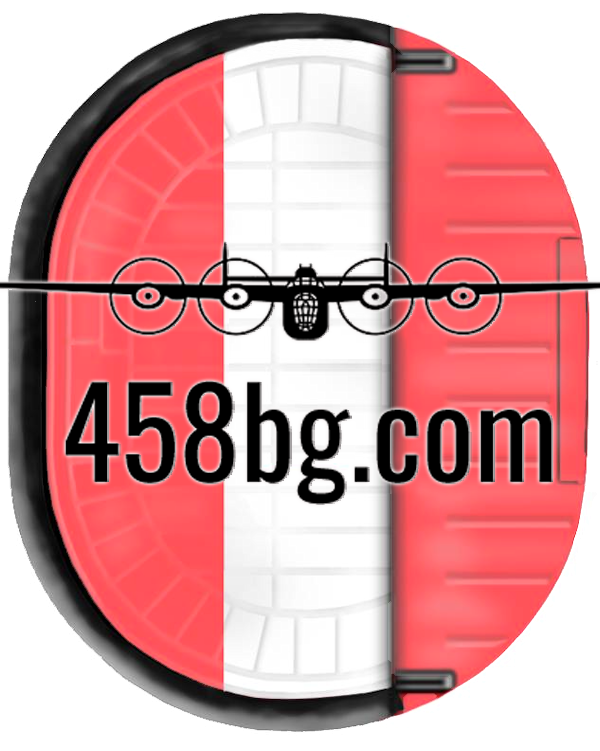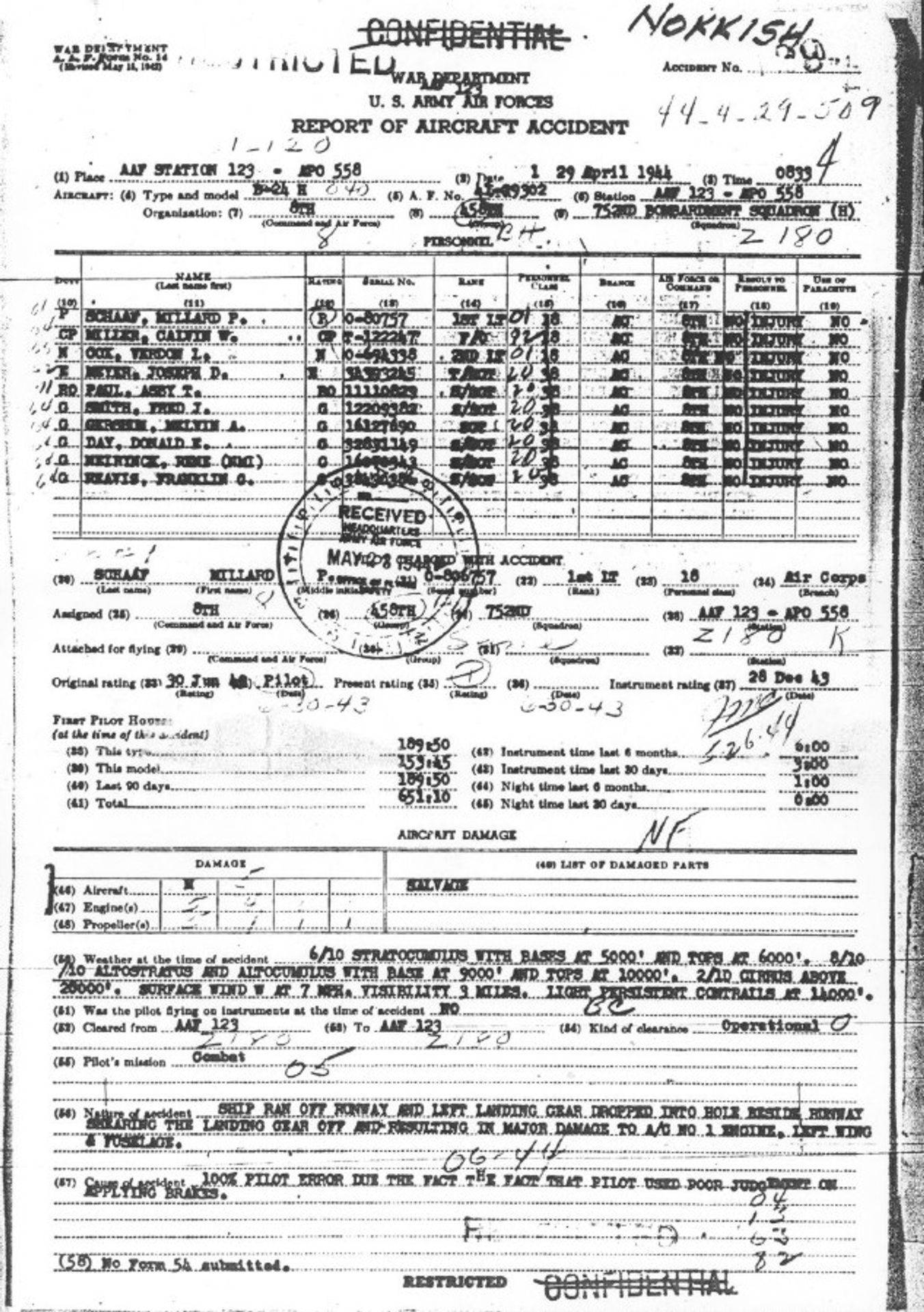Crew 17 – Assigned 752nd Squadron – October 13, 1943

Completed Tour
| Rank | Name | Serial # | Pos | Date | Status | Comments |
|---|---|---|---|---|---|---|
| 1Lt | Lawrence F Menz | 0737191 | Pilot | 29-Dec-43 | TRSF | Reld fr 458BG asgd to 470BG Mt Home, ID |
| 1Lt | John H Hejl | 0811075 | Co-pilot | 26-Feb-45 | KIA | 390BS 42BG Pacific Theater |
| 1Lt | Verdon L Cox | 0694338 | Navigator | Jul-44 | CT | Awards - Distinguished Flying Cross |
| 1Lt | Edward C Eichorn | 0752807 | Bombardier | 06-Jun-44 | UNK | Mission Load List |
| T/Sgt | Asby T Paul | 11110829 | Radio Operator | Jul-44 | CT | Awards - Distinguished Flying Cross |
| T/Sgt | Joseph D Myer | 34393245 | Flight Engineer | Jul-44 | CT | Awards - Distinguished Flying Cross |
| S/Sgt | Rene Neirynck | 16070343 | Aerial Gunner/2E | Jul-44 | CT | Awards - Distinguished Flying Cross |
| S/Sgt | Fred J Smith | 12209383 | Aerial Gunner/2E | Jul-44 | CT | Awards - Distinguished Flying Cross |
| S/Sgt | Donald E Day | 32831149 | Armorer-Gunner | 06-Jun-44 | UNK | Mission Load List |
| S/Sgt | Franklin G Reavis | 38430386 | Armorer-Gunner | Jul-44 | CT | Awards - Distinguished Flying Cross |
Crew 17 under 2nd Lt Lawrence F. Menz, trained at Tonopah, Nevada with the 458th in the fall and winter of 1943. Prior to moving to England, Lt Menz was replaced as the pilot on the crew by 2Lt Millard P. Schaaf, co-pilot on Crew 14. At the same time Lt. John Hejl, Crew 17’s co-pilot, damaged his ears in training dives. He was also taken off the crew. Hejl was later put on twin-engine planes and sent to the Pacific area. His plane and crew were lost in bad weather over the Pacific Ocean in February 1945.
After Hejl was removed from the crew, it is unknown who may have taken his place as co-pilot. Several mission load lists are available for Schaaf, and three different names appear as his co-pilot, the most prevalent being 2Lt Calvin W. Miller, original co-pilot of Crew 5.
S/Sgt Rene Neirynck recalls that, “When the 458th shipped out from Tonopah to overseas, 500 pilots and crews were accidentally left behind. We woke up the next day with no food, no Post Exchange – nothing! One officer found out where we were supposed to go (Hamilton Field, CA) and we all headed there on our own. We were given ten days to show up at Hamilton Field. From that point on we were all shipped in small groups, and flown to Scotland by pilots ferrying planes to England.”
Upon their arrival, crews began training for flying in England. On February 25, Schaaf and crew flew a diversionary mission to the Dutch Coast. Their first combat mission on March 3, 1944 was to Berlin, but bad weather forced the heavies of the Eighth to return without reaching the city. Three days later, Crew 17 was in on the first successful American raid on the German capital. The crew again went to Berlin on March 22nd, and their final trip to that city on April 29th would end shortly after take–off, when the crew were forced to abort and cracked up on landing.
The crew would round out their tour with two missions on D-Day. Most of the crew were awarded the Distinguished Flying Cross, in July and returned tot he States for reassignment.
Stateside – 1943
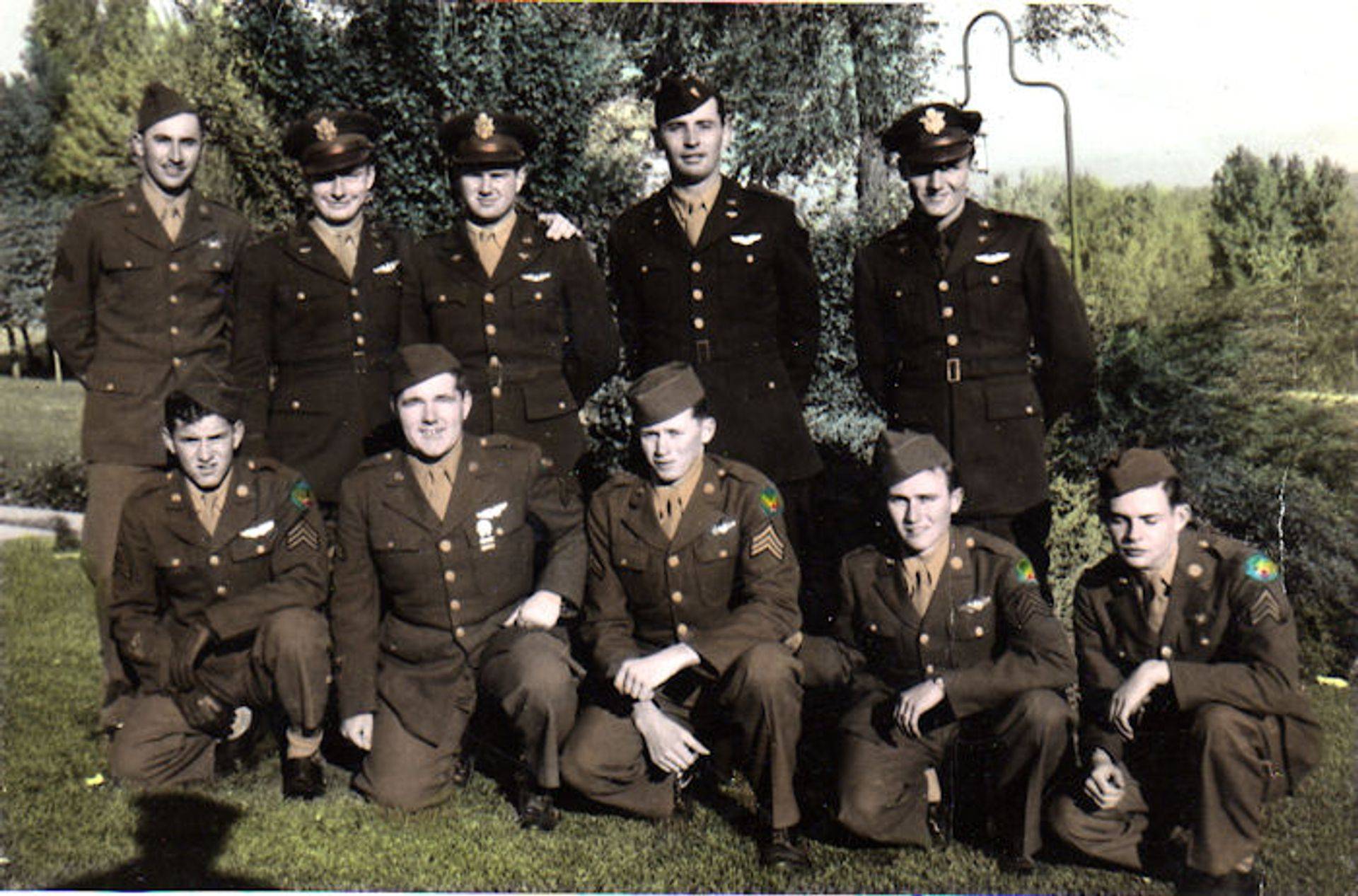
Missions
| Date | Target | 458th Msn | Pilot Msn | Serial | RCL | Sqdn | A/C Msn | A/C Name | Comments |
|---|---|---|---|---|---|---|---|---|---|
| 25-Feb-44 | DUTCH COAST | D2 | -- | 41-28669 | -- | 7V | D2 | GINNY | Diversion Mission |
| 03-Mar-44 | BERLIN | 2 | 1 | 41-29352 | -- | 7V | 1 | WOLVE'S LAIR | |
| 06-Mar-44 | BERLIN/GENSHAGEN | 4 | 2 | 41-28718 | M | 7V | 4 | BO | |
| 09-Mar-44 | BRANDENBURG | 6 | 3 | 41-29302 | P | 7V | 3 | NOKKISH | |
| 15-Mar-44 | BRUNSWICK | 7 | 4 | 41-29329 | L | 7V | 4 | FRITZI | |
| 16-Mar-44 | FRIEDRICHSHAFEN | 8 | 5 | 42-52455 | O | 7V | 3 | PLUTOCRAT | |
| 21-Mar-44 | WATTEN | 10 | 6 | 41-29329 | L | 7V | 7 | FRITZI | |
| 22-Mar-44 | BERLIN | 11 | 7 | 41-29329 | L | 7V | 8 | FRITZI | |
| 24-Mar-44 | ST. DIZIER | 13 | 8 | 41-28718 | M | 7V | 12 | BO | |
| 26-Mar-44 | BONNIERES | 14 | 9 | 42-52457 | Q | 7V | 6 | FINAL APPROACH | |
| 27-Mar-44 | BIARRITZ | 15 | 10 | 41-29302 | 7V | 7 | NOKKISH | ||
| 08-Apr-44 | BRUNSWICK/WAGGUM | 17 | 11 | 42-52457 | Q | 7V | 9 | FINAL APPROACH | |
| 09-Apr-44 | TUTOW A/F | 18 | ABT | 41-29302 | P | 7V | -- | NOKKISH | #2, 4 ENG TEMPS |
| 10-Apr-44 | BOURGES A/F | 19 | 12 | 42-52455 | O | 7V | 13 | PLUTOCRAT | |
| 11-Apr-44 | OSCHERSLEBEN | 20 | 13 | 41-29352 | K | 7V | 10 | WOLVE'S LAIR | |
| 12-Apr-44 | OSCHERSLEBEN | REC | -- | 42-52455 | O | 7V | -- | PLUTOCRAT | RECALL |
| 19-Apr-44 | PADERBORN A/F | 23 | 14 | 42-109812 | D | 7V | 10 | UNKNOWN 016 | |
| 22-Apr-44 | HAMM M/Y | 25 | 15 | 41-29302 | P | 7V | 12 | NOKKISH | |
| 24-Apr-44 | LEIPHEIM A/F | 26 | 16 | 41-29302 | P | 7V | 13 | NOKKISH | |
| 25-Apr-44 | MANNHEIM A/F | 27 | 17 | 41-29302 | P | 7V | 14 | NOKKISH | |
| 27-Apr-44 | BONNIERES | 29 | 18 | 42-52457 | Q | 7V | 19 | FINAL APPROACH | ZIMERMANN X'd OUT |
| 27-Apr-44 | BLAINVILLE-SUR-L'EAU | 30 | NTO | 41-29303 | H | Z5 | -- | LIBERTY LIB | #1 SUPER CHGR FAIL |
| 29-Apr-44 | BERLIN | 31 | ABT | 41-29302 | P | 7V | -- | NOKKISH | Landing Acc Sta 123 |
| 11-May-44 | EPINAL | 39 | 19 | 42-50314 | L | 7V | 5 | ETO PLAYHOUSE | |
| 12-May-44 | BOHLEN | 40 | 20 | 42-50314 | L | 7V | 6 | ETO PLAYHOUSE | (M/F)? |
| 13-May-44 | TUTOW A/F | 41 | 21 | 42-50314 | L | 7V | 7 | ETO PLAYHOUSE | |
| 19-May-44 | BRUNSWICK | 42 | ABT | 42-50314 | L | 7V | -- | ETO PLAYHOUSE | COULD NOT FIND FORM |
| 20-May-44 | RHEIMS A/D | 43 | 22 | 42-50314 | L | 7V | 8 | ETO PLAYHOUSE | |
| 21-May-44 | SIRACOURT | 44 | ABT | 42-50314 | L | 7V | -- | ETO PLAYHOUSE | #2,4 SUPER CHGs |
| 23-May-44 | BOURGES | 45 | 23 | 42-50314 | L | 7V | 9 | ETO PLAYHOUSE | |
| 24-May-44 | VILLEROCHE | 46 | 24 | 42-50314 | J | 7V | 10 | ETO PLAYHOUSE | |
| 25-May-44 | MULHOUSE M/Y | 47 | 25 | 42-95179 | X | 7V | 2 | HERE I GO AGAIN | |
| 27-May-44 | NEUNKIRCHEN | 48 | 26 | 42-50314 | L | 7V | 11 | ETO PLAYHOUSE | |
| 28-May-44 | ZEITZ | 49 | 27 | 42-50314 | L | 7V | 12 | ETO PLAYHOUSE | |
| 30-May-44 | ZWISCHENAHN A/F | 51 | 28 | 42-50314 | L | 7V | 14 | ETO PLAYHOUSE | |
| 31-May-44 | BERTRIX | 52 | 29 | 42-50314 | L | 7V | 15 | ETO PLAYHOUSE | |
| 04-Jun-44 | BOURGES A/F | 54 | 30 | 42-50314 | L | 7V | 17 | ETO PLAYHOUSE | |
| 06-Jun-44 | COASTAL AREAS | 56 | 31 | 42-50314 | L | 7V | 18 | ETO PLAYHOUSE | MSN #1 |
| 06-Jun-44 | PONTAUBAULT | 58 | 32 | 42-50314 | L | 7V | 19 | ETO PLAYHOUSE | MSN #3 |
2Lt Lawrence F. Menz
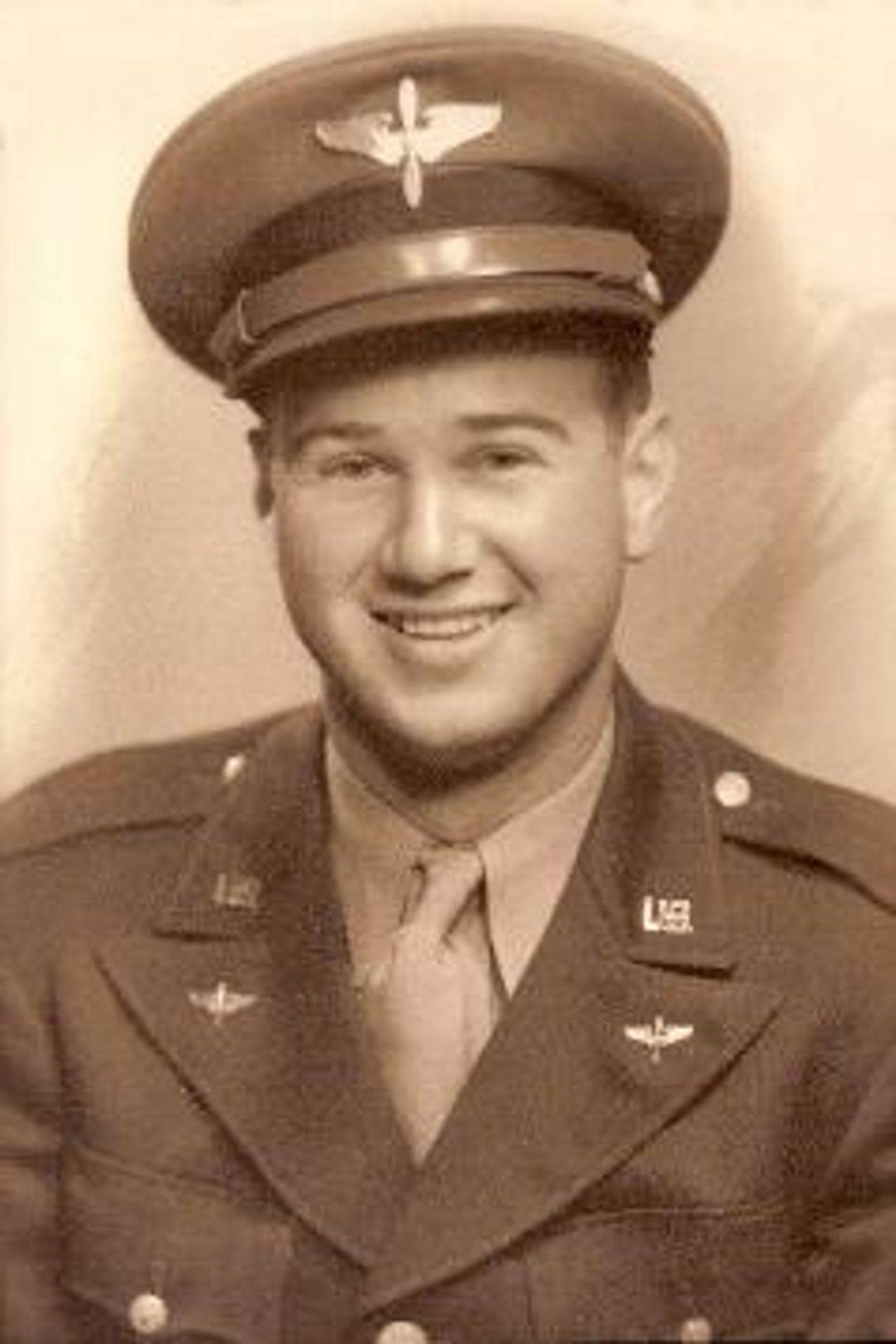
On December 29, 1943, Menz was assigned to the 470th Bomb Group (H) at Mt. Home, Idaho. No specific reason was given for the transfer from the 458th Bomb Group to the 470th Bomb Group. From all of the included paperwork, it appears Menz never entered into combat, and instead remained stationed in the United States, acting as a ferry pilot for various types of aircraft until the end of the war.
According to gunner S/Sgt Rene Neirynck, “The last part of our training at Tonopah was for the gunners to shoot at a sleeve target. During our turn to shoot, the tow plane broke down so we missed the training. Lt. Menz refused to go into combat without that training and was taken off Crew 17.
Recently some of Lt. Menz’s war memorabilia has surfaced. Clint Daniels has created a fantastic tribute to many individuals, including Lt Menz at his website The C.E. Daniel Collection.
Some of Lt Menz’s items can be viewed here: Lawrence F. Menz and the 458th Bomb Group (H).
(Courtesy: C. E. Daniel)
March 27, 1944
Mission to Biarritz, France
“The flight had been a long one, ten hours to the boarder of France and Spain, and back to the southern shores of England. We had been fueled with gas for a ten hour flight and we had been one of the first planes to take off. On the flight back the pilot called and asked us to look for a hole in the clouds to see if we were over land or water. We had only about ten minutes of fuel left. One gunner called in and said, ‘I see both land and water’.
“The navigator had been checking our location and immediately looked for the closest emergency field to land on. We contacted the field and were given instructions to find it as it was totally camouflaged. When the tower man saw us, he explained that he would have to talk us in as the field was invisible from the air. We were about 100 feet above the runway before we saw it. The pilot had been telling the tower that we were coming down in a farmer’s field. The English tower man kept repeating, ‘Believe me sir, we are well camouflaged. You are doing fine’.

“We finally landed and turned off as we were told onto a side track which ran right into a large hill with cows and horses on it. The pilot screamed to the tower “”I am going to hit a hill””. Again we were reminded that we were OK and should be ready to hit the brakes hard. Just as we were about to hit the hill, the side of it opened up about 200 feet and we taxied into an enormous hanger filled with British bombers. The tower man yelled, ‘Hit the brakes!’ and we were home safe. We were fed immediately and stayed overnight as we still had about 200 miles to get to our base. To kill time, we got a good look at the British Air Force. We were taken thru all the different bombers and fighters that had come in with damage and had to find an emergency field. The browsing cows and horses on the roof of the hanger were all made out of paper-mache and were just part of the camouflage.”
(Courtesy: Rene Neirynck via his son John)
April 29, 1944
DESCRIPTION OF ACCIDENT
Lt Schaaf in A/C 41-29302 had a landing accident at the end of Runway 05 on the 29 April 1944.
Lt Schaaf making an early return from a mission made a normal landing. Nearing end of runway he started to apply brakes, which, Lt Schaaf claims did not take hold immediately. When the brakes did take, the left brake locked and the right brake did not operate. Causing A/C to be pulled off the runway to left and the left landing gear dropped into a hole, dug for lighting facilities and sheared the gear off.
The power section of No. 1 engine ad prop was broken completely off. No. 2 prop bent. Left wing damage and severe damage to fuselage.
The braking system on the right wheel was checked and found to be in good working order with no malfunctions. The tire marks show that the right brake took hold approximately 5 [feet] after the left.
It is recommended that the pilots start using their brakes sooner after landing rather than waiting until they are near the end of the runway.
PILOT’S STATEMENT
MILLARD P. SCHAAF, 0-806737, 1st Lt. AC, 752nd Bombardment Squadron, 458th Bombardment Group (H), AAF 123, APO 558.
A/C accident occurred on runway 0-5 at approximately 0845, 29 April 1944, AAF Station 123, APO 558. A/C involved was #41-29302, B-24 H.
I aborted from an operational [mission] and had made a normal landing on runway 0-5. Nearing end of runway I applied my brakes, they failed to respond on further application of pressure, the left brake locked and the right brake would not work.
I tried to straighten A/C by engines but the left wheel, having been already off the runway, ran into a trench which was dug along the edge of runway by contractors installing a lighting system.
Left landing gear collapsed as a result of running into the ditch. The propeller on number one engine was torn loose from engine. The prop on number two was bent and the left wing was damaged considerably. The fuselage was also damaged.
S/Sgt Rene Neirynck’s recollection of this incident
“In regard to Peter Schaff being absent from combat for two weeks. Date April 29, 1944 mission to Berlin. To the best of my memory, we returned to base early when ‘Pete’ (age about 21). suddenly developed a severe case of combat fatigue. Pete took off his oxygen mask and had about 10 minutes to live. Altitude about 30,000 feet. Pete sat on the floor below the top turret.
“The co-pilot called the radio man and asked him to give Pete oxygen from his mask and try to get him back in his pilots seat. Pete began to struggle with Paul and Paul dropped his mask. I could not leave my turret to help (top turret), so the co-pilot called the first engineer in the waist section to come and help. Joe grabbed a walk-around 8 minute oxygen bottle and helped Paul to get Pete in his seat and hooked up to oxygen again. The first engineer, Joe, stayed behind Pete just in case something happened to the co-pilot. Both engineers could fly the plane but we could not land it. From there on Pete just sat there like a zombie. When we got back to England, Pete was placed on two weeks R&R and came back fit as a fiddle. No more problems after that one.”
B-24H-10-CF 41-29302 7V P Nokkish
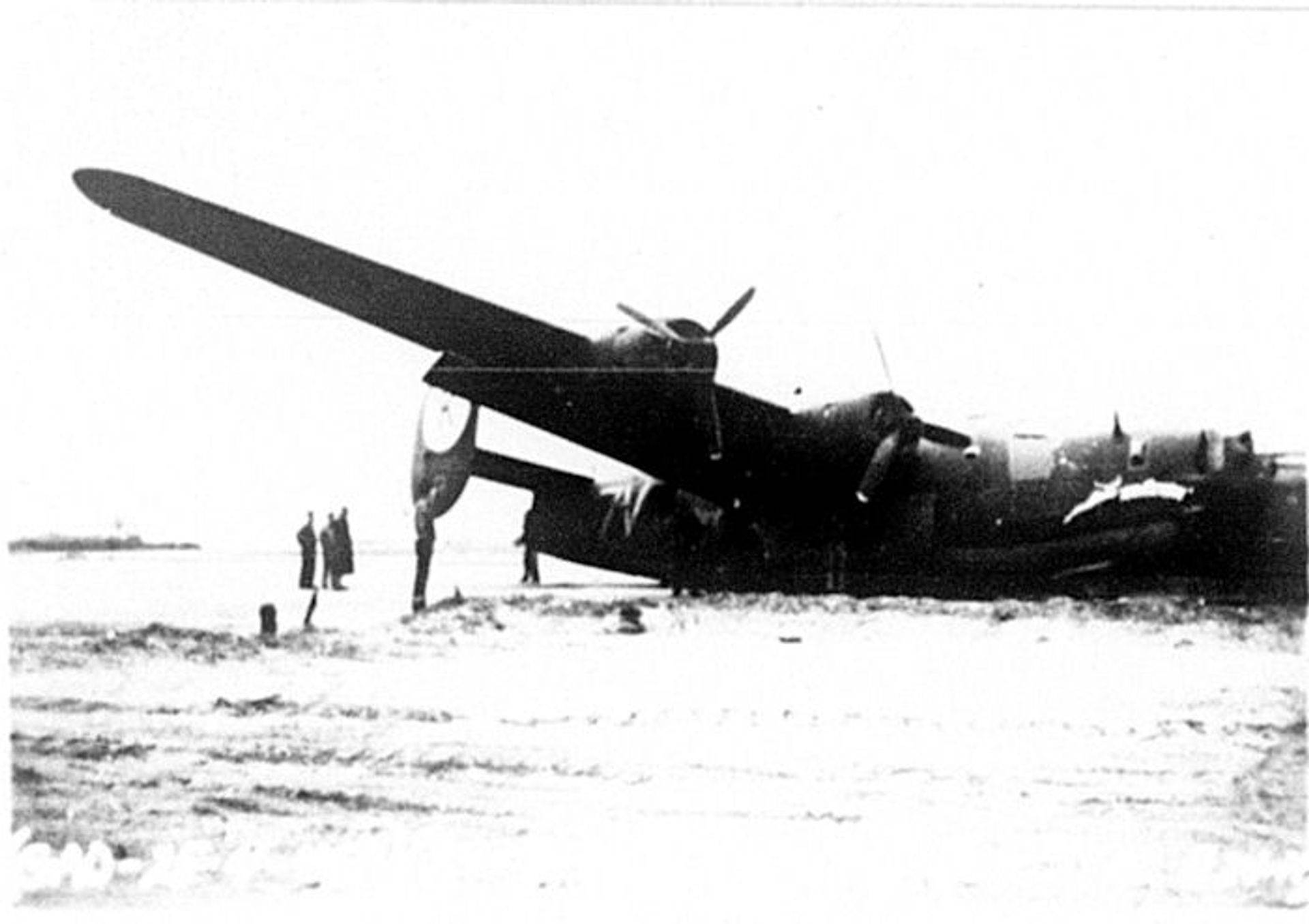
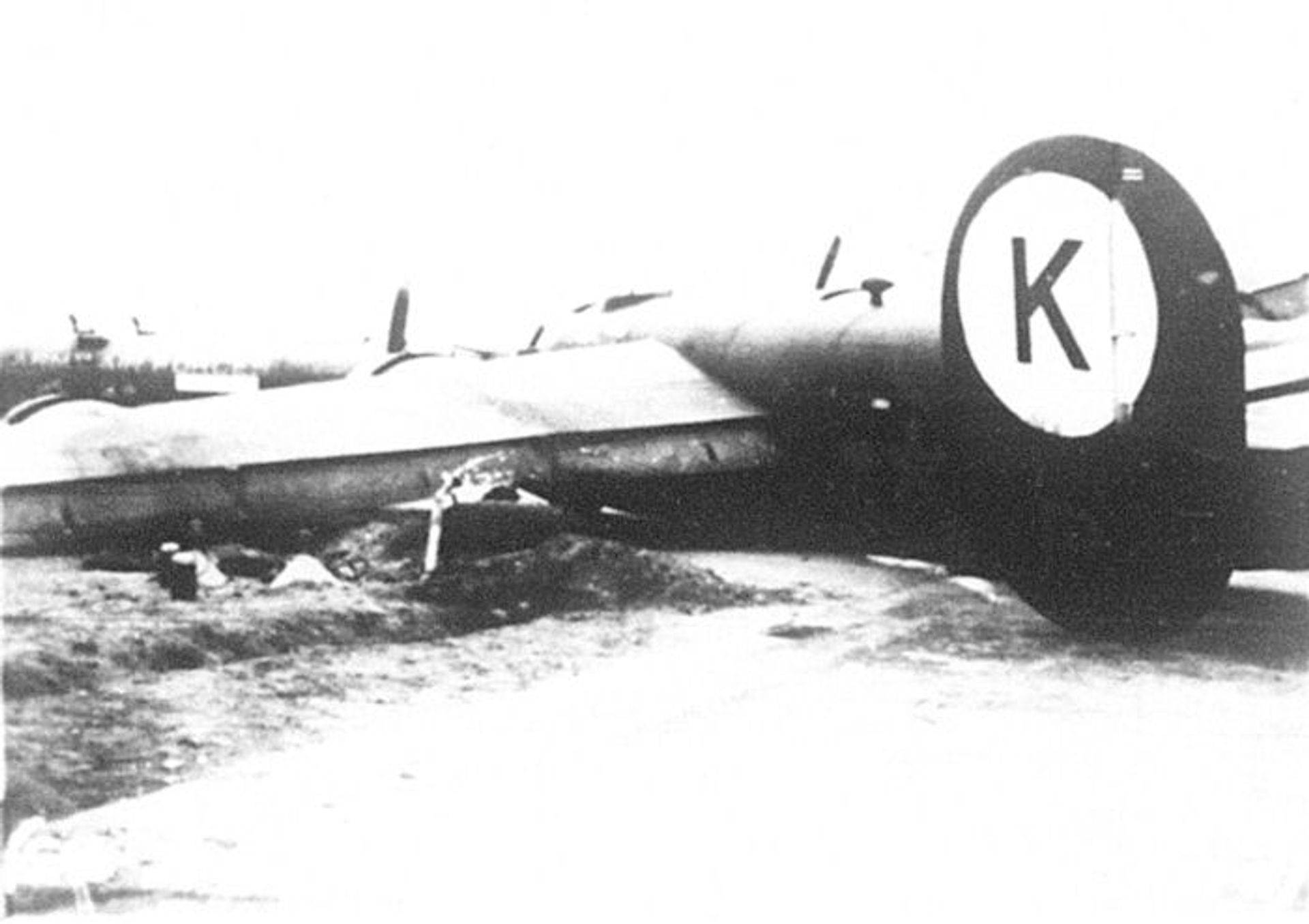
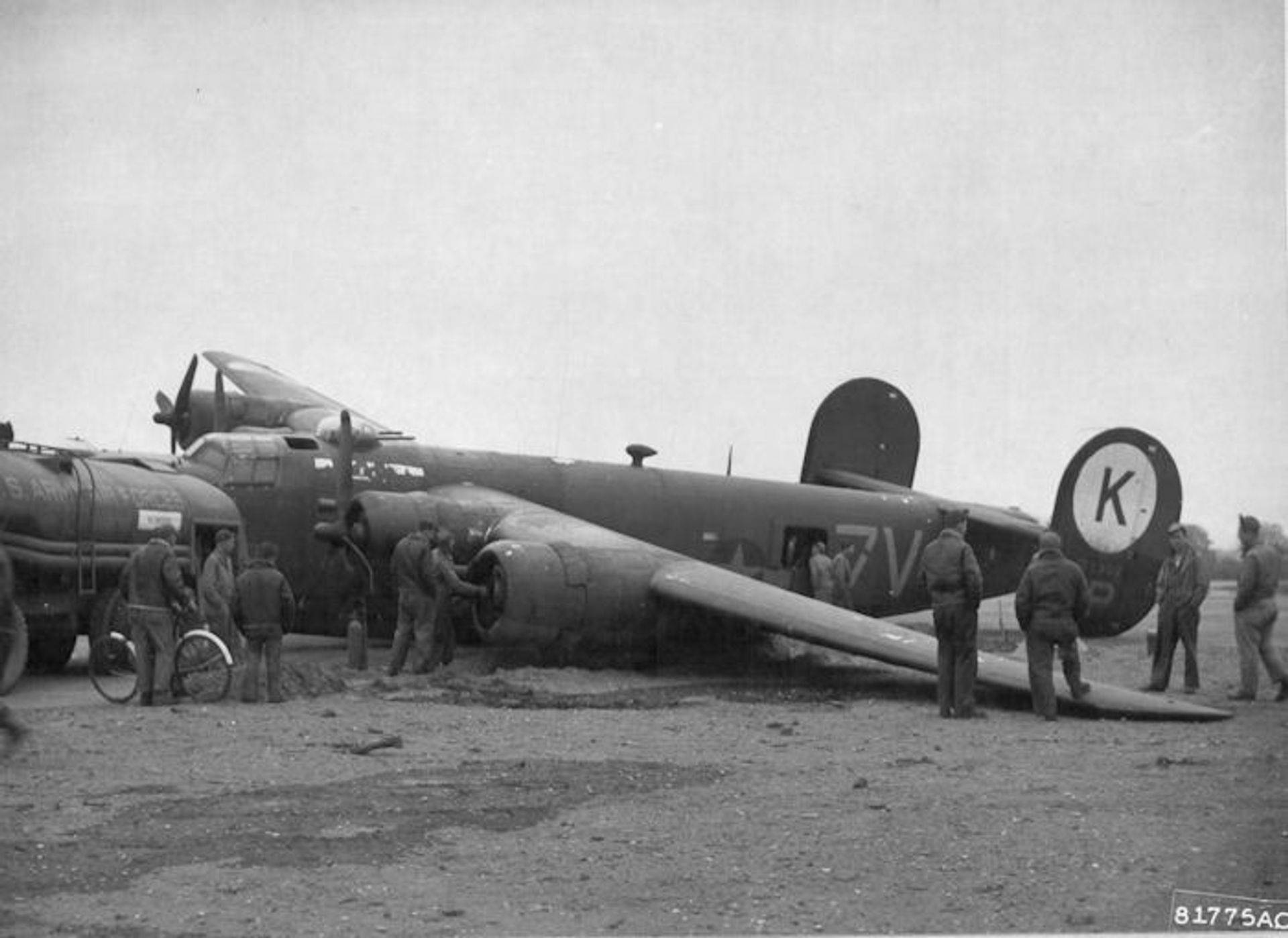
(Images: FOLD3 & Accident Report)
Sgt Rene Neirynck’s Mission List
| Date 1944 | Target | Notes |
|---|---|---|
| March 6 | Berlin, Ger | (700 men lost) incendiaries, 100 lb. |
| March 9 | Hanover, Ger | Incendiaries, 100 lb. |
| March 15 | Brunswick, Ger | Incendiaries, 100 lb. |
| March 16 | Friedrichshafen, Ger | (Zeppelin factory) incendiaries, 100 lb. |
| March 21 | St. Omer, France | 4-2000 lb. bombs |
| March 22 | Berlin, Ger | (650 men lost) 10-500 lb. bombs |
| March 26 | Amiens, France | 10-500 lb. bombs |
| March 27 | Biarritz, France | 240-25 lb. frags (dropped on German Air Force barracks at lunch time) |
| April 8 | Brunswick, Ger | 240-25 lb. frags |
| April 10 | Bourges, France | 6-1000 lb. Bombs |
| April 11 | Oschersleben, Ger | 6-1000 lb. bombs |
| April 19 | Paderborn, Ger | 40-100 lb. bombs |
| April 22 | Hamm, Ger | Rail yards, 10-500 lb. bombs |
| April 24 | Leipheim, Ger | 40-100 lb. bombs |
| April 25 | Mannheim, Ger | 40-100 lb. bombs |
| April 27 | Bonnier, France | 12-500 lb. bombs |
| April 29 | Berlin, Ger | Abort - no mission credit |
| May 11 | Epinal, France | Rail yard, 5-1000 lb. bombs |
| May 12 | Leipzig, Ger | Oil refinery, 40-100 lb. bombs |
| May 13 | Tutow, Ger | FW-190 plant, 10-500 lb. bombs |
| May 20 | Rhiems, France | 10-500 lb. bombs |
| May 23 | Bourges, France | 24-250 lb. bombs |
| May 24 | Paris, France | 10-500 lb. bombs |
| May 25 | Mulhouse, France | Rail yards, 10-500 lb. bombs |
| May 27 | Neunkirchen, Ger | 10-500 lb. bombs |
| May 28 | Zeitz, Ger | 40-100 lb. bombs |
| May 30 | Oldenburg, Ger | 12-500 lb. bombs |
| May 31 | France | Rocket ramps, 240-25 lb. frags |
| June 4 | Bourges, France | 240-25 lb. frags |
| June 6 | Normandy | 5:00 A.M. Invasion, hit beaches, 12-500 lb. bombs |
| June 6 | Normandy | Afternoon, Hit river bridges to stop Rommel from reaching invasion beaches, 12-500 lb. bombs |
Crew 17 – England 1944
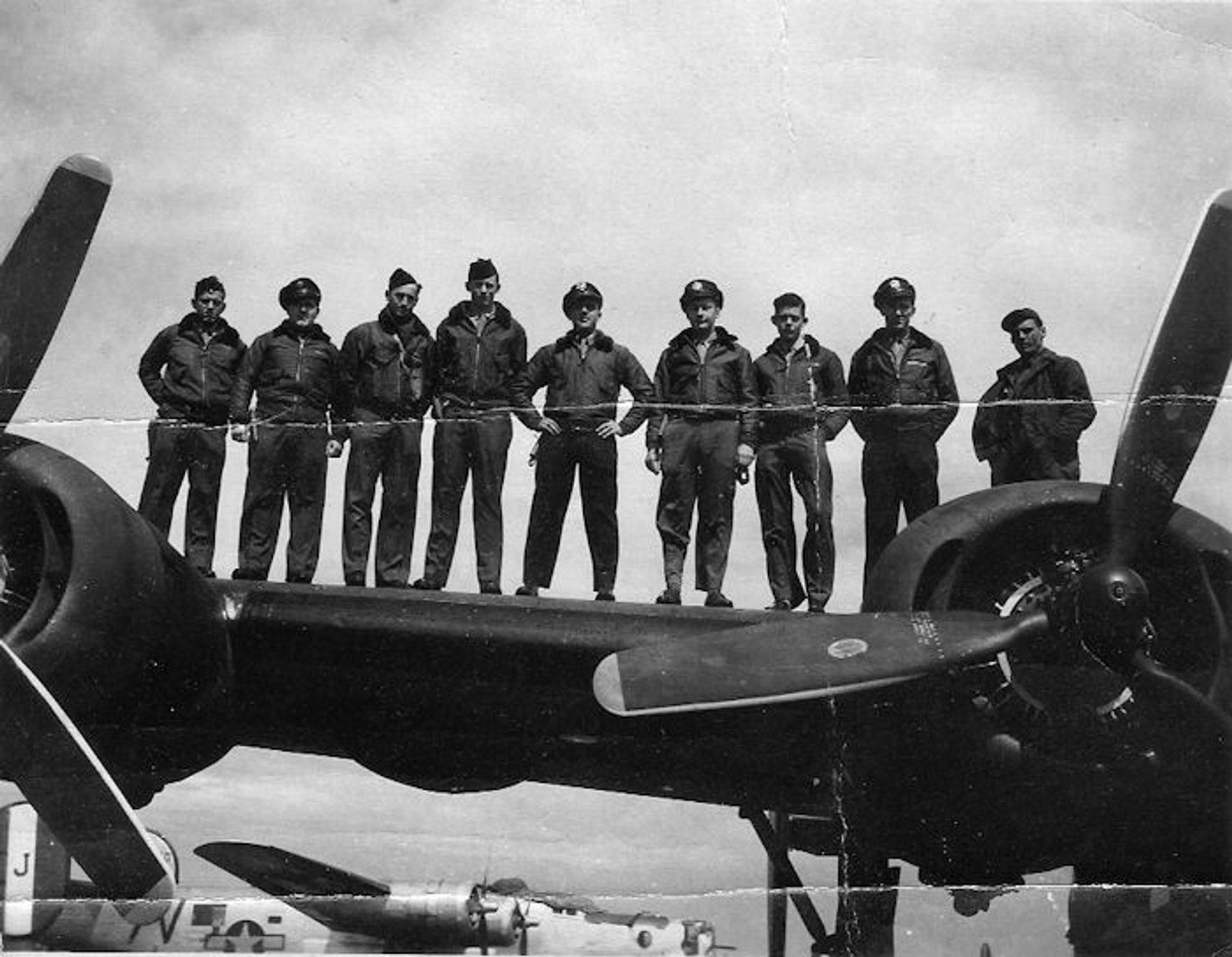
(Photo: John Nierynck)
Sgt Donald E. Day

Our base was located in a suburb of Norwich. England called Horsham/St.Faith rear an inlet on the East coast called The Wash. We were fortunate in that we took over an existing Royal Air Force base.
“The sound was deafening, the ground trembled and the majestic power of all those planes flying in perfect formation was frightening.”
The details of how I came to arrive at my Squadron HQ alone are fuzzy but I handed in my travel orders and was directed to some buildings across the runway. The base was not operational so I started to hike across the field lugging a large, soft-sided bag called a B-4 bag and a large duffle bag with all my worldly possessions. It was very early in the morning and the whole place was silent until I heard a soft rumble that grew into a roar as first one and then ten and then thirty and then hundreds of B-245 came over the horizon and overflew our field at low altitude. I dropped my bags and just stood there awestruck. The sound was deafening, the ground trembled and the majestic power of all those planes flying in perfect formation was frightening. I couldn’t imagine what it must be like to know that they were coming after me with evil intent. At that moment I realized that we were no longer playing games. This was War. I am no author and I can’t really find the words to express the stupendous emotional impact.
I crossed the rest of the runway and found a brick, two-story house among many, that had once been Married Officers Quarters for the RAF in peacetime. The ground floor consisted of a Utility room (with a large cast-iron pot built over a low firebox, a laundry sink and the electrical service board), a kitchen and a dining room with a coal-burning fireplace. A stairway off the living room led up to a bathroom at the head of the stairs and one large and one small bedroom each with it’s own small fireplace. This was the home for 12 men. The enlisted men from one crew had the ground floor and our crew (# 17) had the first floor. Four men slept in the living room and big bedroom and two men slept in the Kitchen and small bedroom. Thank goodness we didn’t have to live in half-round corrugated metal buildings called Nissen-huts.
A Bombing mission over Germany
It is 3:30 AM. A voice says, “Crew 17 – breakfast at 4 briefing at 5 are you awake?” You get dressed. Long underwear, long socks, shirt, trousers, a vest, a silk scarf, a jacket. You leave as quietly as possible to avoid disturbing the crew on the ground floor. It is cold and dark out and as you walk towards the mess hall the cuckoos in the hedgerows complain. Breakfast is powdered eggs and Spam, brown bread and coffee. You are trying to wake up but not think about what is coming. You get to the Ready Room and wait. At the front of the room is a large board covered with a white sheet. After everybody is there an officer comes in and pulls the sheet aside. You watch, as a red tape crawls across a map of Europe and pray that it isn’t too long. This is your mission path. It has several legs and turns to confuse the enemy and accommodate crossing the coast where (you hope) there is still a gap in the flak defenses. Sometimes the Germans have plugged a gap with railroad mounted guns. You get-your take-off time, your target, bomb load, altitude, navigational headings and times, and radio frequencies. You also get an IFF (Identification Friend or Foe) code. You are told what kind of fighters you can expect as escort and when and where they are supposed to show up. Everybody takes notes. Today YOU are going after a synthetic petrol producing plant in central Germany. Armament is 12x500lb armor piercing bombs with variable time-delay fuses, and 2,700 gals of petrol. The B-24 is rated at 8,800 lbs of bombs and 2,280 gallons of gas, but it can’t do both, so you trade off between gas and bombs. Briefing over, you go to your locker and pull out your heated-suit. It is supposed to be good for -20 F but a good many times at 25,000 feet the thermometer in your plane, which will register to -40 (where Fahrenheit and Celsius cross), is knocking on the peg. You put on pants and a jacket which have connections for felt boots and gloves. Experience has taught you to put on another pair of socks, silk gloves inside the felt and take a bath towel and a balaclava to the plane with you. You get the guts of two, caliber 50 machine guns, grab a truck or a jeep which is circling the field, and drop off at your plane. You check your guns and install them, then check the operation of the turrets and see if the correct bombs have been loaded. Check the shackles from which they hang or help load them if it is just being done. The fuses should have red noses. This denotes a time-delay (1/10th of a second to 144 hours) fuse that cannot be removed without exploding the bomb. Everybody does his job and checks up on everybody else. When everything is done ten men line up under the wing for pee call. It is going to be a long time before you get home.
The form-up plane takes off. It is painted with bright red, blue and yellow circles so it stands out. Climb aboard, start the engines. The sound of four 1,250 horse radial engines is a physical thing. Taxi in line. One plane takes off on the right side of the runway and the next on the left to avoid prop wash from the preceding plane. Your turn. The crew in the rear is up against the bomb-bay bulkhead to center the weight as much as possible. You really sweat take-off because the planes are always overloaded and they just stagger into the air. Find the form-up plane and your place in the formation. Wrap the bath towel over the silk scarf and tuck it in. Put on the balaclava climb into your turret. Load your guns. (1,250 rounds per gun fired at a rate of 850 round per minute. Can’t waste it). Continue to circle until your group and the wing is assembled. Start climbing. ‘OXYGEN’ 10.000 feet and you clip the oxen mask over your face. Remember to squeeze it every few minutes or it could freeze up. ‘FEET WET’ you are crossing the English coast. “TEST FIRE” guns rattle a short burst. “CHECK” “waist ok, tail ok, nose ok ,ball ok, top ok, radio ok.” Silence.
‘FLAK AT 12 O’CLOCK’. Into Belgium. Little gingerbread men appear suddenly in the formation. At a close burst the plane rocks. You clear the coast and the barrage falls away. The plane flying on your wing is so close you can see the pilot’s faces. Time passes, its cold and the wind beats on your back. A speck! ‘FIGHTERS 8 O CLOCK HIGH’ Watch. ‘LITTLE FRIENDS 47s’ – the escort is here. Stay alert. Oxygen check. ‘NAVIGATOR TO PILOT- IP (Initial Point of bomb run. You must fly straight and level at 165 mph) IN 12 MINUTES’ ‘ROGER’ ‘NOSE-FLAK AT 2 O’CLOCK’. ‘TOP-LITTLE FRIENDS ARE LEAVING’. The formation spreads a little. ‘NAVIGATOR TO PILOT – IP IN 1 MINUTE, ALTITUDE 24,000, HEADING 135 SPEED 165’ ‘ROGER’ The flak is pouring up, some of it so close you can hear it. Some really big bursts. Has to be 155s. You’re sitting on your flak jacket. ‘NAVIGATOR – IP’. PILOT IT’S ALL YOURS IKE’ ‘ROGER’ the bombardier now controls the plane. ‘DOORS OPEN’. ‘BANDITS AT 12 HIGH’ a burst from the nose. ‘BANDITS NOW AT 10 HIGH ‘ they are looking for somebody asleep. ‘BANDITS ON ATTACK RUN’. BOMBS AWAY! ‘ The tail gunner has been kneeling at the open bottom hatch with a large camera. Suddenly he clicks it twice, throws it aside, and heads for his turret. ‘CLOSE THE DOORS, WE’RE GETTING THE HELL OUT OF HERE’. The plane banks steeply left. The wingman has gone down and right. In a few minutes you are out of the barrage and trying to reform. ‘NOSE – 16 BANDITS AT 11 HIGH. FWs – ON A RUN’. The 467th is at 7 o’clock low.
‘TAIL TO NAVIGATOR 4-6-7 PLANE IS HIT. DROPPING BEHIND AND LEFT. GEAR DOWN. TWO, THREE, FOUR FIVE, SIX, SEVEN MEN OUT. DAMN! SHE BLEW!, FIVE CHUTES OPEN. SIX CHUTES. THAT’S ALL.’ ROGER’ ‘TOP – LITTLE FRIENDS ARE BACK -51s. DOGFIGHT AT 5 LEVEL’. You’re headed home. All you have to do is stay alert and suffer. You’re so cold you can barely stand it. One more flak barrage at the Channel. ‘FEET WET’. ‘FEET DRY’ Beautiful England below. Descending. Getting warm. Break the ammo and fire your guns dry. Pull and bag them. You are in the pattern. A plane with wounded is firing red flares and gets priority landing. Your turn. Pete greases it in, taxis to the revetment and shuts them down. The absence of noise is almost as painful as the start up. A jeep pulls up. ‘Casualties?’ ‘None’. He pulls away. Everybody has a white spot where the oxygen mask was circled by black dirt.
The rest of the routine is – Debriefing, where the whole crew talks to an Intelligence officer. We describe the enemy fighters and how the 467th plane went down. Before debriefing we can get a cup of coffee and a shot of whiskey. Some of my crew doesn’t drink, so some of us get two. Then you clean your guns. Then you eat. Usually Spam, canned mashed potatoes, Brussels sprouts, brown bread and powdered milk or coffee.. It is going on 6 PM. and lights out. You go home and sleep. Tomorrow you will go into your pub and they will know that, today, you all came back, because they count you off (30 planes) and count you on. The days 27 or 28 come back, they leave you alone for a while. Do this 30 times and you can go home. And we did. But they didn’t send us home right away because we flew our last 2 missions on D-DAY and they held on to us for a while just in case.
In early fall of 1944 we boarded the old SS America and sailed from Liverpool to Boston.- I was given a short leave and reported from that to Atlantic City N.J. for reassignment. I took the mental and physical tests for pilot and after I qualified – I had to volunteer for a second tour of duty before entering training. I was sent to Biloxi, Miss to wait for a class. Training was divided into 4 parts. Pre-flight (San Antonio, Tx). Primary (Tulare,Ca) in light aircraft (Stearmans). Basic (Bakersfield, Ca) on heavier aircraft (AT-6s – look like a Japanese Zero), and Advanced where they would decide whether you would be a fighter or a bomber pilot. I had passed all my flight checks for Advanced when V-J Day came. I had enough service and combat points that I was eligible for immediate discharge and I had had enough of the army, so they sent me to Houston, Tx and got rid of me. There!
(Courtesy: SecondWorldWar.nl)
2Lt John H. Hejl
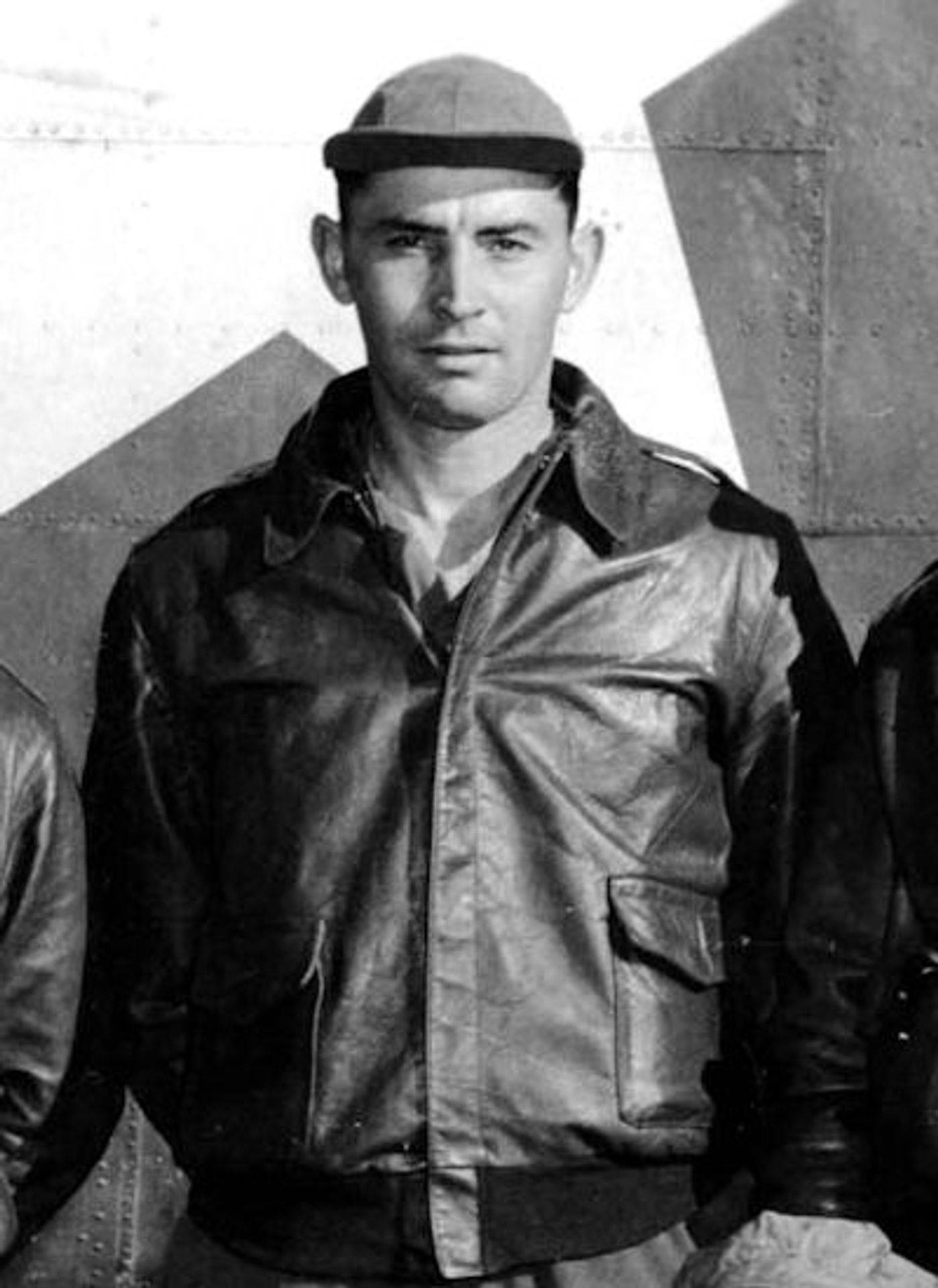
After being transferred in December 1943, John Hejl was eventually assigned to the 42nd Bombardment Group flying B-25’s in the Pacific Theater. His activities with that unit are unknown, but his crew was lost on February 26, 1945 “due to weather.” With no traces of the aircraft or crew, the search was abandoned on March 6, 1945.
—————————————————————————
390TH BOMBARDMENT SQUADRON (M) APO 719-2
Statement of person last to see aircraft #42-64907 B-25G-13, piloted by Lt. Louis R. Verzi, 0-815790, on 26 February 1945.
Lt. Verzi was flying number 2 position in the first element of the 390th Squadron, flying third in the Group formation.
At approximately 0908 we entered the overcast, flying a tight formation in an effort to maintain visual contact between ships. After flying a very short time in the weather, visibility between ships became worse and it was at this time, approximately 0910, that I, Flight Officer Charles S. Kuder, T-3341, co-pilot in the lead ship of the Squadron, last had sight of Lt. Verzi. At that time the weather thickened, causing loss of visual contact between ships. Upon coming out of the weather, Lt. Verzi was not in his respective position.
The approximate location of L. Verzi at the time last seen was eight miles south of Sangihe Island. The course at that time was 295 degrees. Frequent storms occupied the area with visibility in the storms 0 to 500 feet and visibility out of storms from 20 to 25 miles.
/Signed/
CHARLES S. KUDER, T-3341
Flight Officer
From MACR 12774
The officer in charge of the search was Captain CORNELIUS D. MURPHY, 0-795039. A search was conducted on 27 February 1945 for missing aircraft by two B-25’s of the 75th Bombardment Squadron (M), 42nd Bombardment Group (M), Morotai Island and six Catalina’s from the Air Sea Rescue Squadron. The areas searched were from 126 degrees east to 128 degrees east and from 02 degrees north to 04 degrees north, with negative results. Twenty-four B-24’s on the same day from the 307th Bombardment Group (H), Morotai Island, conducted a search in the same area while en route to their target. Results were negative.
Another search was conducted on 28 February 1945 for missing aircraft by six B-25’s of the 390th Bombardment Squadron (M), 42nd Bombardment Group (M), Morotai Island, with negative results…
For additional information on the loss of this crew see the Pacific Wrecks website, and this article on Lt.Louis Verzi.
Rene Neirynck – October 2015
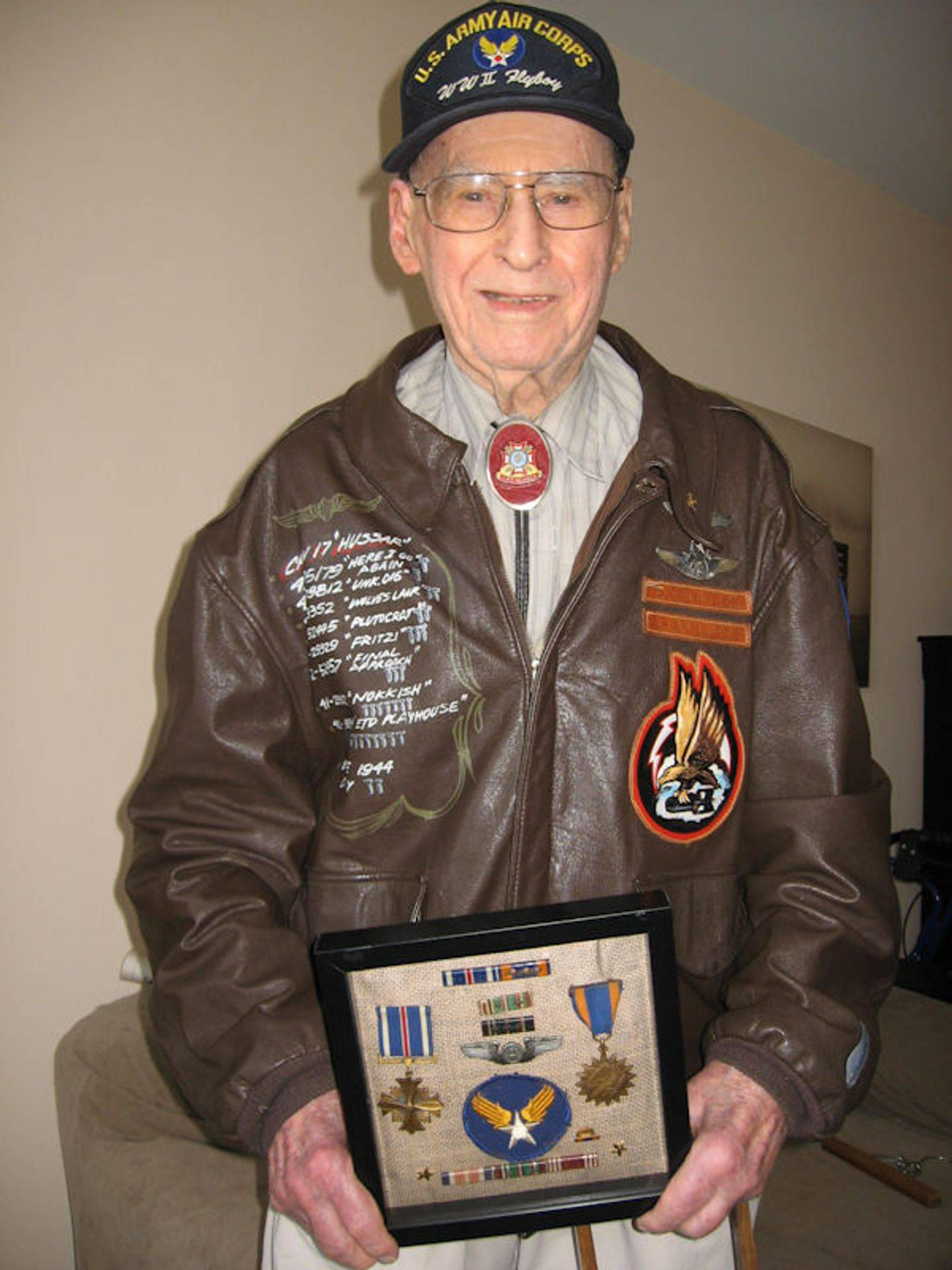
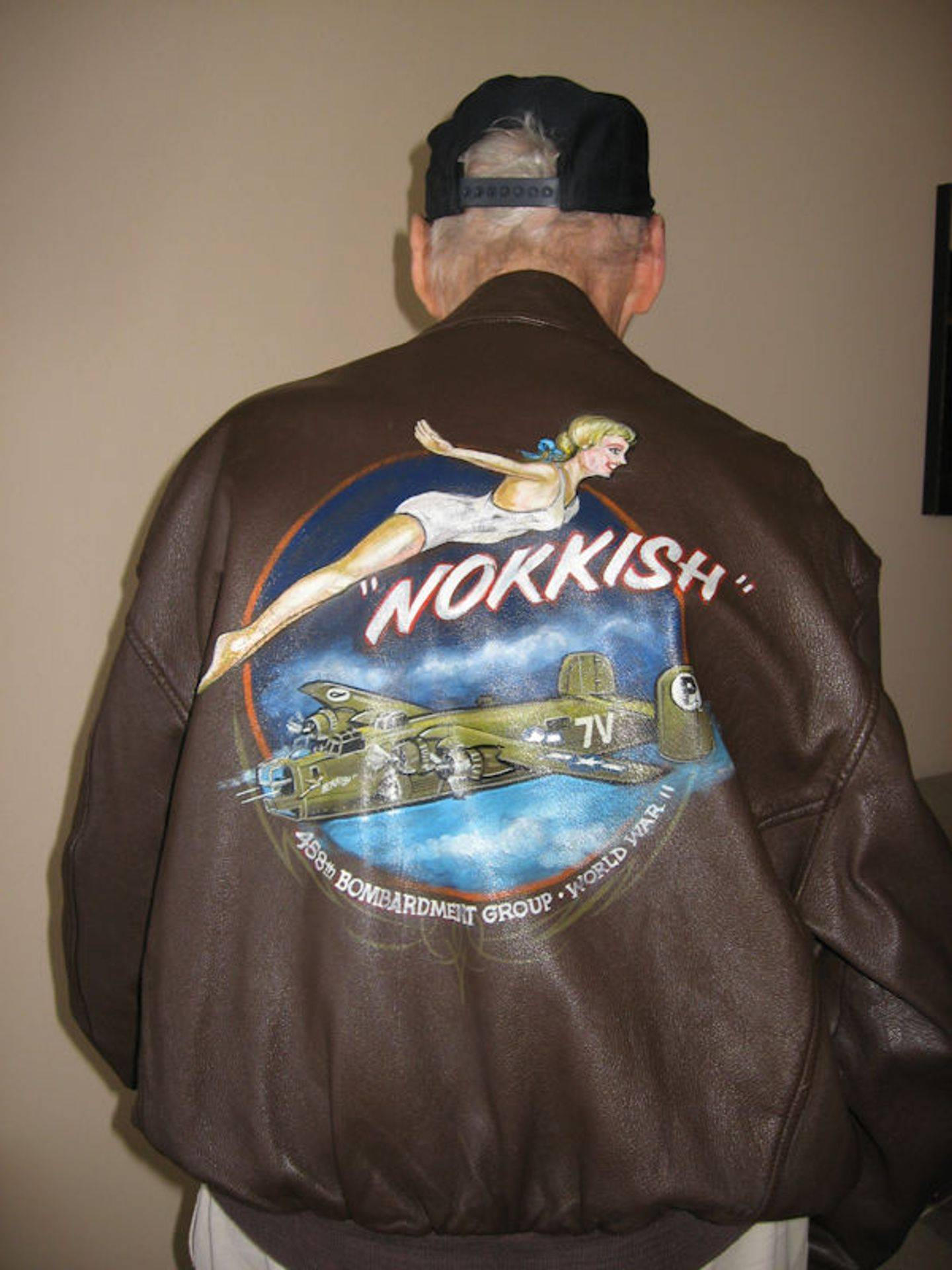
(Courtesy: John Neirynck)
